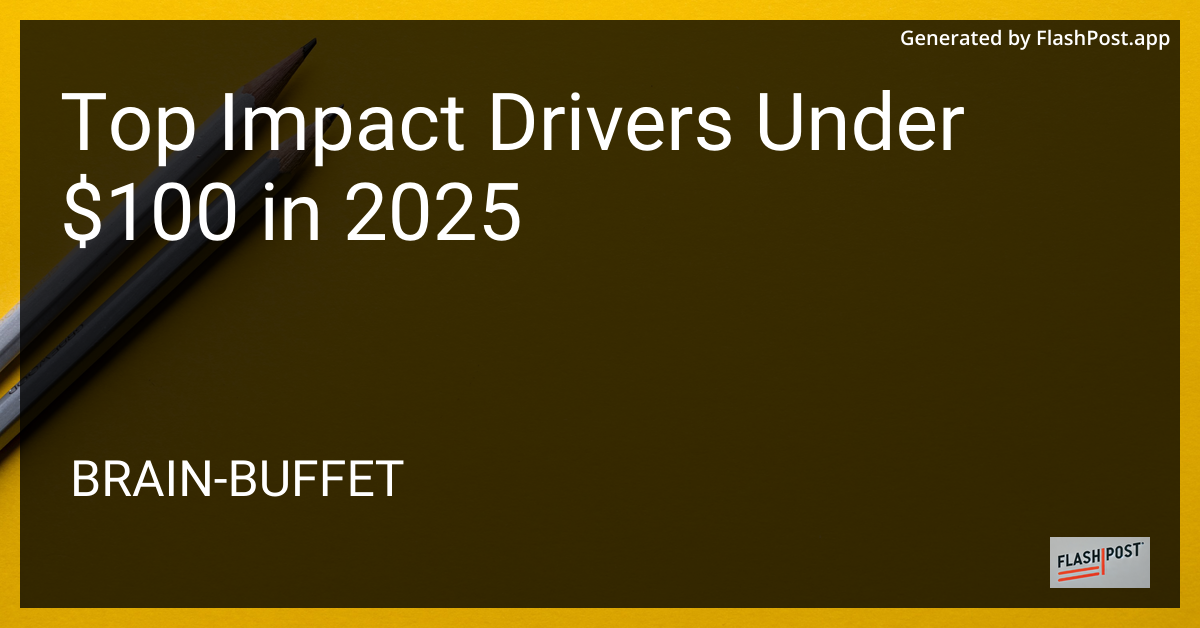Impact Driver Buying Tips You Need in 2025

Best Impact Drivers to Buy in 2025
| Product | Features | Price |
|---|---|---|
 CRAFTSMAN 20V MAX Impact Driver Kit, ¼ Inch, 2,800 RPM, LED Work light, Battery and Charger Included (CMCF800C1) |
– Powerful torque of 1,460 in-lbs for fast, efficient work. – Easy one-handed bit changes for seamless operation. – LED light enhances visibility in dark workspaces. |
Explore Now  |
 DEWALT 20V MAX Cordless Drill and Impact Driver, Power Tool Combo Kit , Includes 2 Batteries, Charger and Bag (DCK240C2) |
– High-performance motor delivers 300 UWO for versatile applications. – Compact design ensures easy access to tight spaces and comfort. – One-handed loading chuck and LED lights enhance efficiency and visibility. |
Explore Now  |
 GoYwato Cordless Impact Driver 2655In-lbs(300N·m) – 21V ¼” Hex Chuck Brushless Hand Impact Driver With & 2 x 4.0Ah Battery & Charger & 14 x Sockets Set & 10 x Screwdriver Bit for Home Projects & DIY |
– High Torque Power: 2655 in-lbs torque for versatile applications. – Dual Batteries Included: Two 4.0Ah batteries for extended runtime. – Ergonomic & Compact: Lightweight design with LED for easy use in tight spaces. |
Explore Now  |
 DEWALT 20V MAX XR ¼ Inch Cordless Impact Driver, Bare Tool Only (DCF860B) |
– Unlock 66% more torque for tackling tough jobs effortlessly. – Achieve 63% faster driving for maximum work efficiency. – Experience precise control with variable speed and 3-speed modes. |
Explore Now  |
 DEWALT 20V MAX Impact Driver, ¼ Inch, Battery and Charger Included (DCF787D1) |
– Longer runtime with brushless motor for durability and efficiency. – Compact design fits easily into tight spaces for versatility. – LED light ensures visibility in dark areas; 20-sec delay for convenience. |
Explore Now  |
Impact drivers are indispensable in every DIY enthusiast's toolkit in 2025. Whether you're a seasoned professional or a weekend warrior, understanding what to look for when buying an impact driver can save you time, money, and avoid unnecessary frustration. This article will walk you through the essential tips for choosing the perfect impact driver tailored to your needs.
Understanding Impact Drivers: The Tool Revolution
Impact drivers have swiftly become the go-to tool for any job involving screws, bolts, and fasteners. Unlike standard drills, impact drivers deliver a high torque output, effectively driving screws into the toughest materials with minimal effort. As with alo yoga leggings' environmental impact, understanding the implications of your purchase is key.
Why Impact Drivers?
Impact drivers are more than just a tool—they're an investment. Imagine you’re facing a complex, demanding project. That's where this powerful tool comes into its own, much like understanding the impact of acquisition on stock options can make or break financial decision-making. Choosing wisely today saves stress tomorrow.
How to Choose an Impact Driver
Choosing the right impact driver can be daunting given the vast options available. Here's a comprehensive guide to simplify your decision-making process:
Key Features to Consider
Torque and Speed: Higher torque is essential for tightening or loosening heavy-duty fasteners. A variable speed control provides flexibility, giving you the precision and power needed across various applications.
Battery Life and Type: Opt for lithium-ion batteries, which are lighter and last longer. Extended battery life ensures uninterrupted work sessions, a critical factor if you're comparing options, much like seeking discounted impact drivers.
Comfort and Ergonomics: Select a tool that feels good in your hand to prevent fatigue during extended use. Consider weight, grip design, and balance for the most comfortable experience.
Durability and Build Quality: Check for rugged construction to withstand job site conditions. Quality manufacturing equates to a tool that can endure rough handling and deliver consistent performance over time.
Additional Features Worth Having
LED Lighting: Brightens up workspaces and improves accuracy, especially in dimly lit areas.
Brushless Motors: They offer improved efficiency, reduced maintenance, and longer lifespan.
Compact Design: Ideal for working in tight spaces and overhead applications where maneuverability is crucial.
Making the Purchase: What to Look For
A prudent purchase decision involves more than just picking a tool off the shelf. Here’s what you need to keep in mind:
Warranty and Customer Support: A robust warranty and accessible customer support can save you headaches in the future.
Compatibility with Accessories: Ensure your impact driver is compatible with your existing tool accessories or has available adapters.
Safety Features: Features like electronic brakes and cooling systems are essential to prevent overheating and ensure user safety.
Where to Buy
With the digital age, purchasing tools online is as simple as clicking a button. Look for online retailers offering competitive warranties and reliable shipping. Keep an eye out for discounted impact drivers to find the best deal.
Frequently Asked Questions
What is the difference between an impact driver and a drill?
Impact drivers are specifically designed for driving screws and bolts. They employ concussive blows, making them more efficient than traditional drills when dealing with tough materials.
Can I use my impact driver as a drill?
While impact drivers can drill holes, they lack the precision of dedicated drills, especially for delicate tasks. For most drilling needs, using the appropriate drill bit alongside an impact driver is recommended.
How often should I replace the battery?
Battery life varies based on use and maintenance. Regular charging and preventing complete discharge extend battery lifespan. On average, batteries last 2-3 years before showing diminished performance.
Are impact drivers safe for home use?
Yes, as long as the user adheres to safety precautions. Wearing protective gear, securing your environment, and understanding the tool's limits and settings are vital for safe use.
The Bottom Line: Equip Yourself Right
The right impact driver can transform your projects, making daunting tasks approachable and manageable. Like understanding the impact of acquisition on stock options, knowing what to look for empowers you to make informed, confident decisions. By following these buying tips, you'll find an impact driver tailored to your unique needs, equipping you for success in 2025 and beyond. Happy toolbox hunting!






































